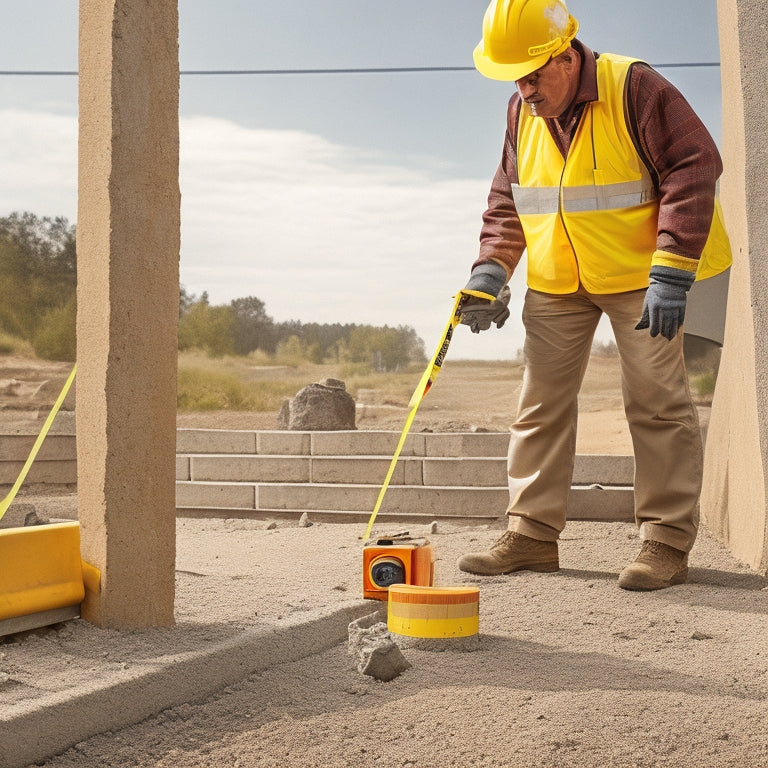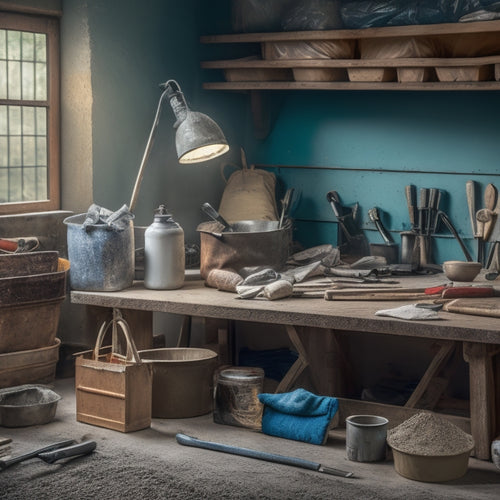
Tools for Accurate Concrete Block Foundation Measurement
Share
To guarantee accurate measurements in concrete block foundation construction, you'll need a variety of specialized tools. Start with essential measuring tools like high-quality tape measures, laser distance meters, and digital calipers for precise length, width, and height measurements. Leveling and alignment devices, such as laser levels and straightedges, help verify foundation layout and maintain stability. Digital measurement devices, including electronic distance meters and smartphone apps, can also streamline the process. Additionally, string and story poles provide visual guidance, while measuring tapes and calipers offer precise measurements. Mastering these tools is key to achieving accuracy - and there's more to explore.
Key Takeaways
• Use high-quality measuring tools like tape measures, laser distance meters, and digital calipers for accurate concrete block foundation measurements.
• Employ leveling and alignment devices like laser levels, straightedges, and squares to ensure precise block positioning and foundation stability.
• Utilize digital measurement devices such as electronic distance meters and smartphone apps for quick and accurate block dimension measurements.
• Establish reference points with string and story poles for visual guidance and to facilitate quick block alignment checks.
• Maintain cleanliness and consistency when using measuring tapes and calipers to ensure accurate readings and prevent measurement errors.
Essential Measuring Tools for Foundations
What tools do you need to accurately measure a concrete block foundation, guaranteeing a solid base for your construction project?
To achieve precise measurements, you'll need a combination of essential tools. First, invest in a high-quality tape measure or a long-steel ruler to capture the foundation's length, width, and height. A laser distance meter can also be useful for calculating longer distances. For more intricate measurements, such as checking the block's dimensions and spacing, use a digital caliper or a precision rule. Additionally, a level and a square will help you verify the foundation's layout and make sure it's plumb and square.
When it comes to measurement techniques, it's vital to establish a reference point, usually the corner of the foundation. From there, take precise readings using your chosen tools, recording each measurement carefully. To guarantee accuracy, take multiple readings and average them.
Consider creating a foundation layout diagram to visualize your measurements and identify any potential issues. By mastering these measurement techniques and utilizing the right tools, you'll be able to create a solid foundation for your construction project.
Leveling and Alignment Devices
You'll need to employ leveling and alignment devices to guarantee your concrete block foundation is perfectly horizontal and vertical, as even slight deviations can compromise the entire structure. These devices assure accurate placement and alignment of blocks, which is critical for the foundation's stability and load-bearing capacity.
Laser levels are essential for achieving precise leveling. They project a level line or plane, enabling you to accurately position blocks and check for deviations. Rotating laser levels, in particular, are useful for large foundations, as they can project a 360-degree level line.
Alignment guides, such as straightedges and squares, help maintain precise block alignment. These guides ensure that blocks are properly positioned and aligned, preventing deviations that can lead to structural issues. When used in conjunction with laser levels, alignment guides provide an added layer of accuracy, assuring your foundation is built to exacting standards.
Digital Measurement Devices
With digital measurement devices, such as electronic distance meters and digital calipers, you can quickly and accurately measure concrete block dimensions, spacing, and layout. These tools enable you to capture precise data, reducing errors and saving time.
Laser distance meters, for instance, can measure distances up to 300 feet with an accuracy of ±1/16 inch, making them ideal for measuring long walls and room dimensions. Digital calipers, on the other hand, allow you to measure block widths, heights, and lengths with precision, guaranteeing accurate spacing and layout.
Smartphone apps, such as construction calculators and measuring apps, can also be used to aid in measurement. These apps can perform complex calculations, convert units, and even provide real-time measurements using the phone's camera and sensors.
String and Story Poles
Measuring concrete block foundations often requires establishing a reference point, and that's where string and story poles come in, providing a visual guide for block placement and layout.
You'll use these tools to guarantee accurate alignment and spacing of blocks, which is critical for a solid foundation. To set up your string, you'll want to anchor it to a stable point, such as an anchor stake, and then tension it to the desired level using a string tensioning tool. This will give you a straight reference line to work from.
When it comes to story pole placement, you'll want to position them at regular intervals along the foundation, typically at corners and mid-points. Make sure they're securely fastened to the ground to prevent shifting or toppling.
With your string and story poles in place, you'll be able to quickly check block alignment and make adjustments as needed. By using these tools in conjunction with one another, you'll be able to achieve precise measurements and a solid foundation that will stand the test of time.
Measuring Tapes and Calipers
Accurate measurements are vital in concrete block foundation construction, and that's where measuring tapes and calipers come into play, providing precise readings of block dimensions and spacing.
As you take on the task of measuring, it's important to master tape measurement techniques. Start by making certain your tape is clean and free of debris, which can affect accuracy. When measuring block lengths, use the hook on the end of the tape to catch onto the block's edge, and take multiple readings to guarantee consistency.
For more precise measurements, consider using a high-quality caliper. To maximize caliper accuracy, verify the jaws are clean and free of debris, and take readings in multiple locations to account for any variations. When using calipers, it's also vital to maintain a consistent pressure to avoid affecting the measurement.
Frequently Asked Questions
Can I Use a Single Tool for Both Measurement and Calculation?
When you're working on a project, you'll often wonder if you can use a single tool for both measurement and calculation.
The answer is yes, you can. Multi-function devices can streamline your process, saving you time and effort.
However, it's essential to guarantee the device you choose prioritizes measurement accuracy, as even slight errors can have significant consequences.
How Often Should I Recalibrate My Digital Measurement Devices?
You should recalibrate your digital measurement devices regularly to guarantee measurement accuracy.
The calibration frequency depends on factors like usage, environmental conditions, and manufacturer recommendations. Typically, you'll want to recalibrate every 3-6 months or after 1,000 to 5,000 measurements.
Additionally, recalibrate if you notice deviations in readings or after exposing devices to extreme temperatures, humidity, or physical shock.
Are There Any Safety Precautions for Using String and Story Poles?
When using string and story poles, you'll want to prioritize safety.
Start by guaranteeing proper string tension to prevent snapping or entanglement.
For story pole safety, always maintain a secure grip and stable footing when handling or climbing.
Wear protective gear like gloves, hard hats, and safety glasses to minimize risks.
Additionally, inspect your equipment regularly for damage or wear to prevent accidents.
Can I Measure Curved Foundations With Traditional Measuring Tapes?
When measuring curved foundations, you'll find traditional measuring tapes aren't the best tool for the job. The rigid tape can't conform to the curve, leading to inaccurate readings.
Instead, you'll need to employ specialized measuring techniques, such as using a flexible curve calculator or a digital distance meter. These tools allow you to capture precise measurements, even on complex curved foundations.
Are There Any Specific Regulations for Concrete Block Foundation Measurement?
You're maneuvering the complex landscape of concrete block foundation measurement, where accuracy is the north star guiding your every move.
When it comes to measurement standards, you'll find that foundation regulations vary by region and country.
In the US, for instance, the International Building Code (IBC) and the International Residential Code (IRC) set the benchmarks.
You'll need to familiarize yourself with local ordinances and industry standards to guarantee your measurements meet the required specs.
Conclusion
As you stand on the foundation site, surrounded by the raw materials of construction, the accuracy of your measurements is the cornerstone of a sturdy edifice.
With these essential tools in hand, you're equipped to build a fortress of precision, where every block fits snugly into place like a puzzle piece.
The digital devices hum with precision, the strings and story poles stretch out like guiding arms, and the tapes and calipers measure with the exactness of a surgeon's scalpel.
Your foundation rises, a testament to the power of accurate measurement.
Related Posts
-

Smart Guide to Buying Used Concrete Hand Tools
You're about to buy used concrete hand tools, and you need to get it right. Dedicate time to identify the tools you n...
-

10 Must-Have Tools for Small Concrete Projects
When tackling small concrete projects, you'll need a range of essential tools to achieve professional-grade results. ...
-

Top Mixing Tools for DIY Concrete Block Laying
When it comes to DIY concrete block laying, the right mixing tools are vital for a strong and durable structure. You'...


